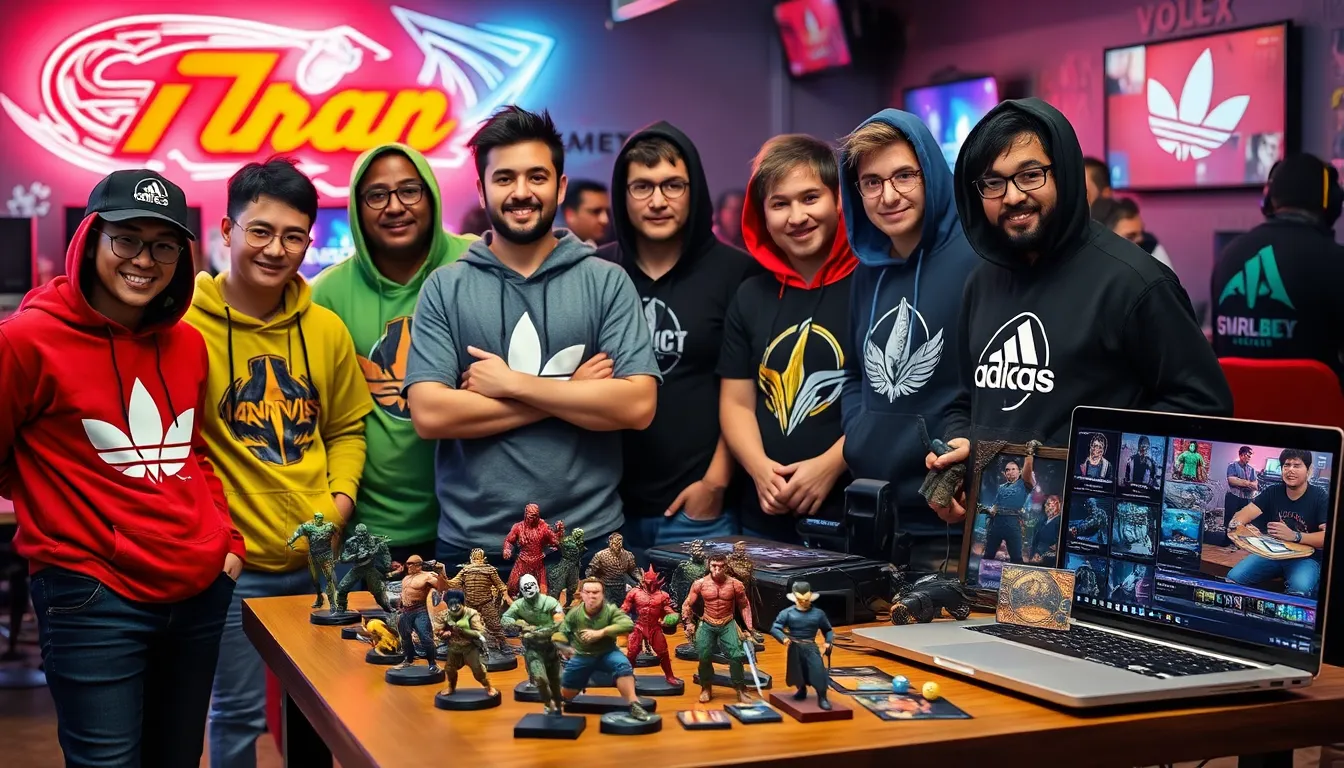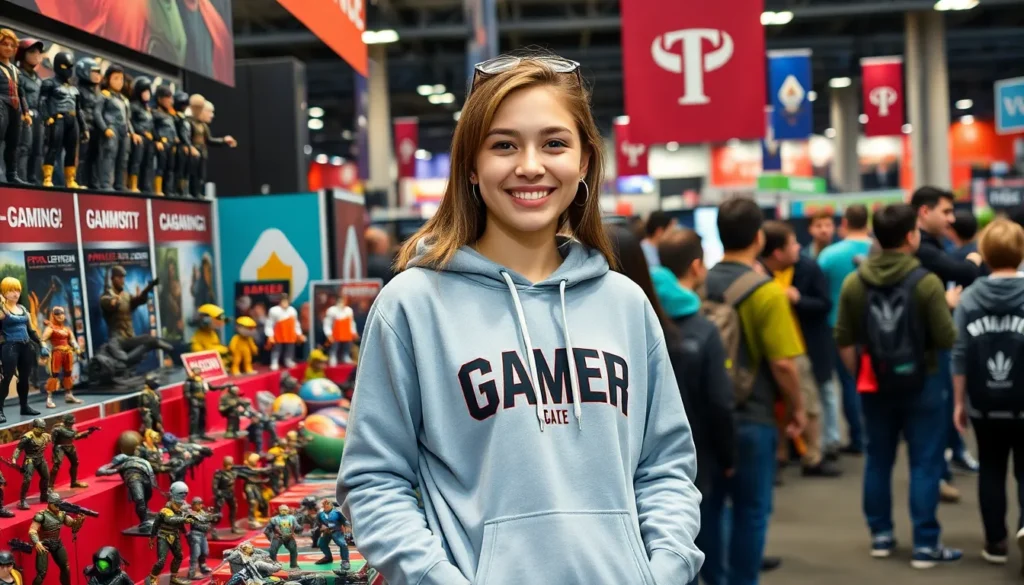Table of Contents
ToggleIn the vibrant world of gaming, merchandise releases have become a vital extension of beloved franchises. Gamers eagerly anticipate the latest collectibles, apparel, and accessories that allow them to express their passion and connect with their favorite titles. From limited-edition figurines to stylish clothing lines, these products offer fans a tangible way to engage with the gaming universe.
As the gaming industry continues to grow, so does the demand for unique and high-quality merchandise. Companies are increasingly recognizing the importance of catering to their audience’s desires, creating a diverse range of products that resonate with fans. This article explores the latest trends in game merchandise releases, highlighting what to expect and how these items enhance the gaming experience.
Overview of Game Merchandise Releases
Game merchandise has transformed significantly, reflecting the growth of the gaming industry. Expanding offerings enhance fan engagement and diversify product types.
The Evolution of Game Merchandise
Game merchandise has evolved from simple figurines and posters to comprehensive collections that include clothing, home decor, and in-game items. Collectibles now often feature limited editions, directly linked to in-game achievements or events. Merchandising strategies now include collaborations with artists and designers, creating exclusive products that appeal to niche markets. Technology advancements enable more interactive items, such as augmented reality features embedded in toys or clothing.
Popular Game Franchise Merchandise
Major game franchises release a wide range of merchandise that resonates with their audiences. Items include apparel like t-shirts and hoodies adorned with iconic logos and designs, collectibles such as action figures and miniature models, and accessories spanning from backpacks to phone cases. Each franchise taps into its unique lore to create compelling merchandise, ensuring alignment with fan expectations. Pokémon, for example, offers plush toys representing various characters, while titles like Call of Duty provide tactical gear and apparel that reflect the game’s military themes.
Types of Game Merchandise

Game merchandise encompasses a wide variety of items, allowing fans to express their connection to games in multiple forms. These products range from clothing and collectibles to interactive in-game items.
Apparel and Accessories
Apparel and accessories represent a primary category of game merchandise. T-shirts, hoodies, and hats often feature iconic logos or character designs, reflecting popular franchises. Additionally, items like backpacks, keychains, and jewelry offer fans subtle ways to show their fandom. Extreme attention to detail in design, often influenced by gaming culture, ensures these products appeal to a broad audience and encourage everyday use.
Collectible Items
Collectible items have gained immense popularity among gamers and collectors alike. Figurines, action figures, and art prints allow fans to obtain tangible representations of their favorite characters or moments. Limited edition releases add exclusivity, fostering a sense of rarity and value. Other popular collectibles include trading cards, poster sets, and displayable artwork, which often serve as conversation starters among enthusiasts.
In-Game Merchandise
In-game merchandise enhances the gaming experience through digital products. Skins, outfits, and accessories customize players’ avatars, allowing for unique expression within the game. Developers often tie in-game merchandise to specific achievements or events, adding a layer of engagement. Collaborations with brands can introduce exclusive content, further deepening players’ connection to the game and extending its reach beyond conventional merchandise.
Major Recent Releases
Recent game merchandise releases highlight the industry’s commitment to appealing to dedicated fanbases. The latest trends showcase innovative products stemming from popular franchises.
Highlighted Games and Their Merchandise
- The Legend of Zelda: Tears of the Kingdom: Merchandise includes collectible figurines, themed apparel, and exclusive art books. Fans appreciate items that reflect the game’s rich lore and characters.
- Call of Duty: Modern Warfare II: This title features a range of tactical gear and apparel designed for both gamers and collectors. Limited edition items often sell out quickly, reflecting high demand.
- Fortnite: Collaborations with brands lead to a diverse range of products, from clothing to action figures. Exclusive in-game items paired with physical merchandise create a cohesive brand experience.
- Super Mario 3D World + Bowser’s Fury: Merchandise focuses on nostalgic designs reminiscent of classic games. Plush toys and themed clothing cater to both new and longtime fans.
Fan Reactions and Sales Performance
- Positive Feedback: Fans respond enthusiastically to high-quality merchandise that captures the essence of their favorite games. Reviews often highlight attention to detail and design accuracy.
- Sales Metrics: Limited edition and exclusive items typically see rapid sell-outs. For instance, the recent release of a special figurine set saw sales exceeding 20,000 units within the first week.
- Market Trends: A surge in merchandise sales reflects the growing integration of physical and digital products. Industry reports indicate a 30% increase in merchandise sales compared to the previous year, showcasing rising fan engagement.
- Social Media Buzz: Significant fan interaction on platforms like Twitter and Instagram amplifies product launches, driving interest and sales. Posts showcasing unboxing experiences and merchandise reveals generate high engagement.
Impact on Gaming Culture
Game merchandise releases significantly influence gaming culture, shaping fan experiences and engagement. The availability of diverse products deepens connections between gamers and their favorite franchises.
Merchandising and Fan Engagement
Merchandising fosters fan engagement through tangible connections to beloved games. High-quality apparel, collectibles, and accessories enable fans to express their enthusiasm and identity. Marketing strategies often include pre-orders and exclusive items that create excitement and urgency. Limited edition releases cultivate a sense of exclusivity, motivating fans to purchase quickly. Social media platforms amplify this engagement, as fans share their collections and experiences, generating buzz and community involvement. Many gamers attend events and conventions to celebrate their passion, often wearing themed merchandise that enhances the communal atmosphere.
Limitations and Criticisms
Despite its benefits, game merchandise faces limitations and criticisms. Some fans argue that product prices often exceed reasonable expectations, making them inaccessible. Others express concerns about the prevalence of low-quality items or exploitative practices hinting at oversaturation in the market. Additionally, comments about the reliance on fan loyalty for financial gain highlight ethical dilemmas. These criticisms encourage companies to focus on quality over quantity, ensuring that merchandise meets fan expectations and fosters genuine connection rather than mere profit-driven motives.
Game merchandise releases have become an essential part of the gaming landscape. They not only enhance the gaming experience but also create lasting connections between fans and their favorite franchises. The evolution of merchandise from simple collectibles to innovative interactive products reflects the industry’s commitment to meeting the diverse interests of gamers.
As demand continues to grow, companies are challenged to deliver high-quality items that resonate with fans. The excitement surrounding limited edition releases and brand collaborations showcases the potential for merchandise to shape gaming culture. With social media amplifying fan engagement, the future of game merchandise looks promising, ensuring that gamers can express their passion in unique and meaningful ways.







